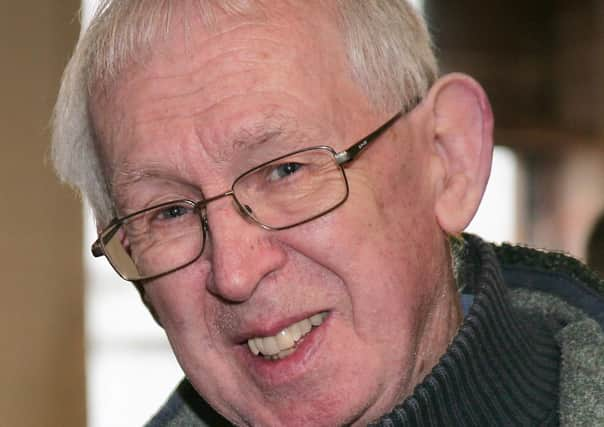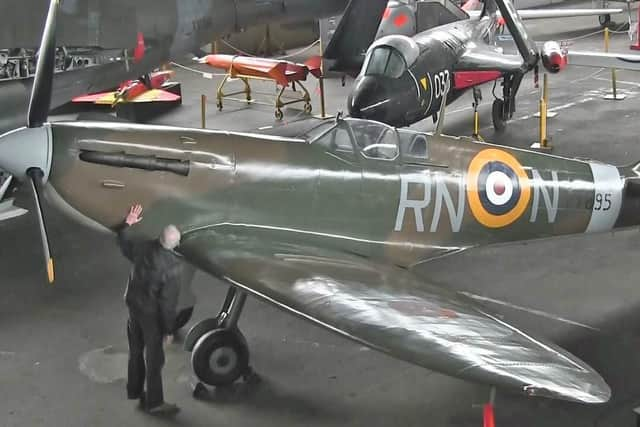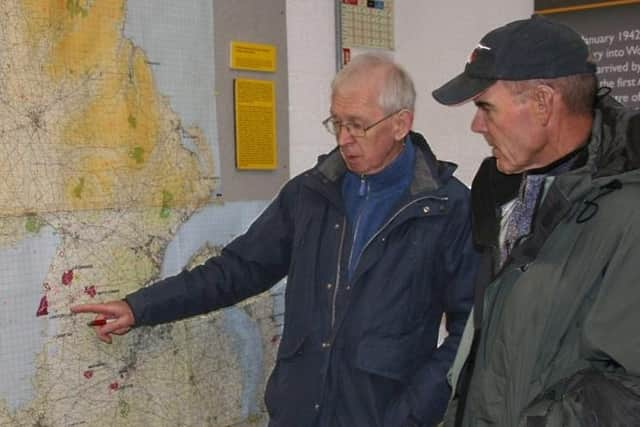The sad passing of an aviation legend


Ernie Cromie, BEM, was 79 years old. Until his death on Friday (July 16), he had been a patient in recent weeks at Lagan Valley Hospital.
The Ulster Aviation Society, where he had served as chairman for 30 years, paid tribute to him as a “a dear friend, a dedicated historian and an inspiration to everyone who knew him.”
Advertisement
Hide AdAdvertisement
Hide AdRay Burrows, who succeeded his colleague in 2012 as chair of the Society, has remembered him as “one of the nicest, most generous-of-spirit men I have had the pleasure of meeting in my life. A giant of a man with the most amazing aviation knowledge.”


About 40 volunteers gathered for two minutes in a silent, spontaneous tribute Saturday at the organisation’s museum at the Maze/Long Kesh site in Lisburn. They represented a membership which has now grown to nearly 700, from its humble beginnings in 1968 of about a dozen enthusiasts.
The very existence of the Society’s assemblage of 40 aircraft, displays and artifacts at Lisburn has been due largely to the commitment during the past 40 years of Ernie and a growing core of enthusiasts within the Society.
Ernie, a retired civil servant with a town planning background, lived with his wife, Lucy, in Hillsborough. He had joined the Society in 1979.
Advertisement
Hide AdAdvertisement
Hide AdHe recently recalled that he’d had an interest in aviation since he was five when he watched from his home, amazed, as a large transport aircraft dropped bundles of fodder to snow-marooned sheep in the nearby Dromara Hills.


As a growing lad, he built aeroplane models and goaded his parents to take him to the annual air shows at Aldergrove. Finally, one day as a young man in 1979, he met another “spotter” who told him about the little Ulster Aviation Society. At that point, the ten-year-old organisation was still just a small, obscure group, lifting binoculars and cheap cameras to the skies near Ulster’s airports.
But, fortunately for them both, Mr. Cromie met Ray Burrows, the start of a bond which only ended with Ernie’s death.
Both young men were frustrated at the limited activities of the UAS. History propelled them toward another aspect of aviation: wreckology, the amateur search and possible recovery of aircraft wrecks.
Advertisement
Hide AdAdvertisement
Hide Ad“I became amazed at the number of aircraft that had crashed in Northern Ireland,” Ernie said in an interview years later. “The vast number of those wrecks were from the Second World War.”
He spent hours, then weeks of time delving into official records. The findings spurred him to head for the crash sites, where he met local people who helped with their own recollections. And once begun, he said, his research became an obsession.
Over the years, he and Ray Burrows led small teams of like-minded Society members into Ulster’s hinterlands to find—and perhaps retrieve—any parts of the aircraft which had met their end.
Ray, years later, recalled those days of amateur enthusiasm: “There was tremendous fun and camaraderie on those trips….Ernie was faster than any of us, during the climbing. Up the Mournes, he was a mile ahead of us!”
Advertisement
Hide AdAdvertisement
Hide AdErnie, in an interview in 2017, laughed as he told of a typical trek.
“It was up on the Garron Plateau (in Co Antrim)…when we brought back a substantial portion of a wing—quite a heavy piece of wreckage—and we had to carry it several miles over peaty, heathery ground. It was very hard going, in the summer. Ray was there, yeah, and a lot of the guys stripped to the waist and the sun beating down….That’s the sort of thing we would do.”
But the wreck recovery which really sparked the birth of an aircraft museum took place at a tiny lough only minutes away from the Society’s present location.
A Wildcat fighter aeroplane had ditched at shallow Portmore Lough near Aghalee in 1944. Local farmers managed to rescue pilot Peter Lock but the hulk itself lay half-submerged for the next 40 years. That is, until a phonecall to Ernie from Ray Burrows: Why not try recovering it?
Advertisement
Hide AdAdvertisement
Hide AdThe rest has become legend in Society members’ memories. With help from a private contractor and a military helicopter, the badly-damaged Wildcat was hauled from the water and sucking mud. It’s been under restoration since then, a major feature of the museum collection.
But more important, its recovery steered the Ulster Aviation Society into a new and very ambitious direction. They would start an aviation museum, with Ernie Cromie as their leader.
Bits, pieces and entire aircraft found their way at various times over the years into members’ garages, a helpful school, an abandoned abattoir, and eventually came together at some old air force buildings at Langford Lodge near Crumlin. In 2005-2006, Ernie and Ray negotiated a deal which ended with the collection installed at its present location in two hangars at the old RAF Long Kesh airfield, Lisburn.
It was never lost on Ernie that the Lisburn area has been rich in aviation history, said Ray. To have such a specialised museum in the city made his colleague especially proud. It’s the largest of its kind in Ireland.
Advertisement
Hide AdAdvertisement
Hide AdOnce in place at its new home, the UAS would need a constitution, Ernie decided. He designed one, framing the Society as a totally volunteer group, which concluded with its formal recognition as an education charity.
Ernie’s excellent leadership, hard work and friendly demeanour have been qualities known to all UAS members for many years, said Ray.
And such recognition went beyond the membership. Ernie received the British Empire Medal, praised for his efforts in the Society to promote heritage. As well, his inspiration was largely responsible for a further royal honour: In 2018, its 50th anniversary, Buckingham Palace presented the Society with the Queen’s Award for Voluntary Service.
Though he handed the leadership reins to Ray Burrows nine years ago, Ernie remained a very active member, particularly in areas of history, with many authoritative articles and several books to his credit. Typically modest, he shied away from personal acknowledgement during an interview in 2018: “The members of the Ulster Aviation Society: They’ve always been enthusiastic with their commitment, being prepared to put themselves out to a tremendous degree, to achieve what we’ve always being trying to achieve.”
A service of thanksgiving for Ernie Cromie will be held Wednesday (July 21st) at 1.30 pm at Lisburn Presbyterian Church.